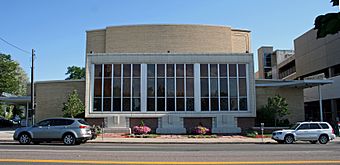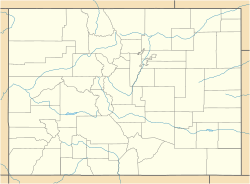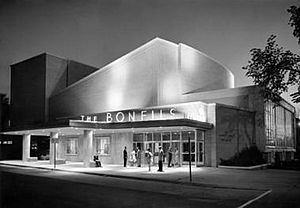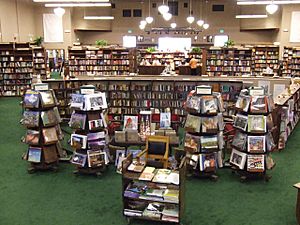Bonfils Memorial Theatre facts for kids
Quick facts for kids |
|
|
Bonfils Memorial Theatre
|
|

Theatre building in 2009
|
|
| Location | 1475 Elizabeth Street, Denver, Colorado |
|---|---|
| Area | Northeast Denver, Colorado |
| Built | 1953 |
| Architect | John K. Monroe |
| Architectural style | Art Moderne |
| NRHP reference No. | 91001417 |
| Added to NRHP | December 27, 2006 |
The Bonfils Memorial Theatre, also known as the Lowenstein Theatre, was a special community theatre in Denver, Colorado. It was located in the Capitol Hill neighborhood and operated from 1953 to 1986. A kind lady named Helen Bonfils built it to honor her parents, Frederick Gilmer Bonfils and Belle Barton Bonfils.
This theater was a busy place! It hosted many different kinds of shows, including plays, operas, concerts, films, and even lectures. Over its years of operation, it put on more than 400 productions. In 1985, the theater was renamed the Lowenstein Theatre. This was done to honor Henry Lowenstein, who had been its producer for a long time. The theater closed in 1986 and stayed empty for two decades. In 2005, it was bought by Charles Woolley. His company fixed it up, and in 2006, it reopened as a Tattered Cover bookstore. The building is now listed on the National Register of Historic Places.
Contents
History of the Bonfils Theatre
The Bonfils Memorial Theatre was designed in a style called Art Moderne. This style was popular for its smooth, curved shapes. The architect who designed it was John K. Monroe from Denver. The building was one story tall and covered a large area. It was made with cream-colored bricks. It also had special trims made of buff-colored terra cotta and red sandstone.
Above the entrance, there was a cool "wing-swept" marquee. This is like a fancy sign that hangs over the door. Below it, a curved aluminum canopy protected people from the weather.
Inside the Theatre
Inside the theater, the lobby was made of travertine stone. It had a "Prussian blue" rug, which is a deep blue color. The walls were covered in wood, and the plaster was a pumpkin color. There were also tall windows that let in light.
One interesting part of the lobby was a small shrine. This shrine was dedicated to the Abbey Theatre in England. To get to the lower lobby and bar, people would walk down a grand staircase.
The main theater area could seat 550 people. The stage curtain was also Prussian blue. The side walls were gray, and the carpet was red. Backstage, there were nine dressing rooms for the performers. The architect, John Monroe, designed a special electronic lighting system. It was a smaller version of the one used in New York City's famous Metropolitan Opera House. This system helped the theater put on many different types of shows. It was also good for use as a television studio.
Helen Bonfils even asked the famous actor Raymond Burr for advice on the theater's layout. Years later, some of the Perry Mason TV movies, starring Raymond Burr, were filmed there. This happened between 1987 and 1989.
Building the Theatre
Helen Bonfils paid $1.25 million to build the Bonfils Memorial Theatre. She was a generous person from Denver and owned The Denver Post newspaper. She built the theater to honor her parents. Helen wanted the theater to be the new home for the University Civic Theatre. This was an amateur theater group that had been performing since 1929.
In 1942, Helen gave the group a different location. But because of World War II, that building could not be fixed up. So, in 1948, Helen bought the property at 1425 Elizabeth Street. She had a ten-room house moved to make space for the new theater. She then rented the new building to the Denver Civic Theatre for just one dollar a year.
The Bonfils Memorial Theatre opened on October 14, 1953. It was the first new live-performance theater to open in Denver in 40 years! It quickly became a very popular place in the city. Helen Bonfils often hosted the opening nights, and important people from society would attend. Even President Dwight D. Eisenhower sent a telegram to Helen Bonfils to congratulate her on the opening. The very first show was a play called Green Grow the Lilacs. About 500 people came to see it.
Shows and Performers
The theater offered many types of shows. These included main stage plays, cabaret shows, and even children's theater. From 1953 to 1986, it put on more than 400 productions. Many talented people performed there. Some of them were John Ashton, Tony Church, and Cleo Parker Robinson.
Famous people who appeared in shows included Helen Bonfils herself, who was an actress and producer. Other well-known performers were Mary Jo Catlett, Julia Child (who gave a cooking demonstration!), Kevin Kline, Patti LuPone, Ted Shackelford, David Ogden Stiers, Marilyn Van Derbur (who was Miss Colorado 1957 and Miss America 1958), Joan Van Ark, Emlyn Williams, and Paul Winfield. Helen Bonfils even let the theater use her amazing collection of fur coats, jewels, silver, furniture, and rugs as props for the shows.
During the summers, the theater had a "summer festival caravan." This caravan would travel to city parks to entertain people. They also put on a free outdoor musical in Cheesman Park.
Henry Lowenstein started working at the theater in 1956 as a set designer. He later became the main producer in 1967. In 1985, the theater was renamed the Lowenstein Theatre to honor him.
Theatre Closure
The theater continued to operate for more than ten years after Helen Bonfils passed away in 1972. In 1973, the Denver Civic Theatre moved to the Denver Center for the Performing Arts (DCPA). The Bonfils Memorial Theatre then came under the control of the DCPA's governing board in 1974. This board was formed from Helen Bonfils' estate.
The board kept the Bonfils Memorial Theatre open as a community theater. However, by 1984, professional theater became more popular at the DCPA. Because of this, the board decided to close the main stage at Bonfils. The cabaret and children's shows continued for a couple more years. But in 1986, the board decided to close the theater permanently.
Renovating the Building
The theater building remained empty for 20 years. In May 2005, Charles Woolley bought the property for $1.9 million. His company then started a big project to fix up and preserve the building. They spent $16 million to turn the theater into a bookstore. They also added a record shop, an art cinema, and a large parking garage next to it.
In June 2006, the building reopened as a Tattered Cover bookstore. Not many changes were made to the outside of the building. However, the sloped floor of the theater had to be made flat. The inside was also redesigned to be a retail store. The architect, Josh Comfort, made sure to keep many of the original "historical details and finishes." For example, some of the original red mohair-covered seats were kept in two areas of the balcony. The original orchestra pit, where musicians used to sit, was filled with books about the performing arts. The backstage dressing rooms, rehearsal area, and offices were changed into a restaurant and coffee shop. The company that did the renovation received an award for their preservation work in 2006.
The theater building was officially listed on the National Register of Historic Places in 2006.





